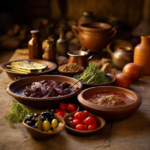In this article, you will embark on a journey to explore the richness of Xinomavro, a captivating Greek wine. Known for its full-bodied flavor, red fruits, and firm tannins, Xinomavro hails from the region of Naoussa. Prepare to be immersed in the vibrant world of this unique varietal as we uncover the secrets behind its delightful characteristics.

History of Xinomavro
Origins of Xinomavro
Xinomavro, meaning “acid black” in Greek, is a red grape variety that has a long and rich history in Greece. The exact origins of Xinomavro are uncertain, but it is believed to have been cultivated in the Macedonia region of Greece for centuries. Its precise origins may be traced back to the town of Koropi, where ancient vineyards have been discovered.
Xinomavro in Ancient Greece
Xinomavro has deep roots in ancient Greece, where it was highly regarded for its robust character and ability to age. In fact, it was mentioned by Aristotle himself, who praised its quality and character. Xinomavro was even used in ancient religious ceremonies and was highly regarded by the ancients for its full-bodied nature and rich flavors.
Revival of Xinomavro
Although Xinomavro has a long history, it experienced a decline in popularity in the 20th century. However, in recent years, there has been a revival of interest in this indigenous Greek grape variety. This resurgence can be attributed to the efforts of passionate winemakers who recognized its potential and sought to showcase its unique characteristics. Through their dedication and skill, Xinomavro has once again become one of Greece’s most revered grape varieties.
Xinomavro Grape Characteristics
Aroma and Flavor Profile
Xinomavro is known for its complex and enticing aroma and flavor profile. It often exhibits notes of red fruits such as cherries and raspberries, along with hints of dried herbs, spices, and earthy undertones. The wine made from Xinomavro grapes has a distinctive character that is vibrant, yet elegant.
Tannins and Acidity
One of the defining characteristics of Xinomavro is its firm tannins and high acidity. These components give the wine structure and longevity, allowing it to age gracefully for many years. The tannins are particularly notable, as they can be quite grippy in their youth, but with time, they soften and integrate beautifully, resulting in a harmonious and well-balanced wine.
Ageability
Xinomavro is renowned for its exceptional ageability. The wine made from this grape variety has the potential to evolve and improve with extended cellaring. As it ages, Xinomavro develops complex tertiary aromas and flavors, gaining depth and nuance. It is not uncommon for well-made Xinomavro wines to age for 10 to 20 years or even longer, rewarding the patience of those who choose to cellar them.
Xinomavro in Naoussa
Naoussa Appellation
Naoussa, located in the Macedonia region of northern Greece, is considered the heartland of Xinomavro production. The Naoussa appellation is known for producing some of the finest Xinomavro wines in Greece. The unique terroir of Naoussa, combined with the expertise of local winemakers, results in wines that truly showcase the potential of this grape variety.
Terroir of Naoussa
The terroir of Naoussa plays a crucial role in the quality and character of Xinomavro wines. The region benefits from a continental climate, with hot summers and cold winters, along with a significant diurnal temperature variation. The vineyards of Naoussa are situated on limestone and clay soils, which impart distinctive mineral notes to the wines. These environmental factors contribute to the development of ripe, flavorful grapes with excellent acidity.
Naoussa Xinomavro Production
In Naoussa, Xinomavro is typically grown as a single-varietal wine. The winemaking process involves careful selection and hand-picking of the grapes, followed by a lengthy maceration period to extract maximum flavor and tannins. The wines are then aged in oak barrels, allowing them to develop further complexity and texture. The resulting Naoussa Xinomavro wines are full-bodied, with intense fruit flavors, firm tannins, and a long, elegant finish.

Xinomavro in Other Greek Regions
Amyndeon Appellation
Xinomavro is also grown in the Amyndeon appellation, located in the Macedonia region of northern Greece. The cool climate and high altitude of Amyndeon contribute to the development of grapes with vibrant acidity and aromatic complexity. The wines produced in this region often display intense red fruit flavors, along with distinctive floral and spice notes.
Goumenissa Appellation
Another region where Xinomavro is cultivated is Goumenissa, situated in the Macedonia region. The vineyards of Goumenissa benefit from a combination of clay and limestone soils, which contribute to the structure and minerality of the wines. Goumenissa Xinomavro wines are known for their elegance, with flavors of ripe red fruits and a balanced acidity.
Food Pairing with Xinomavro
Local Greek Cuisine Pairings
Xinomavro pairs particularly well with traditional Greek cuisine. Its robust character and acidity make it an excellent choice to complement dishes such as moussaka, grilled lamb, or roasted vegetables. The bright fruit flavors and firm tannins of Xinomavro provide a perfect balance to the rich and savory flavors of these dishes.
International Food Pairings
Beyond Greek cuisine, Xinomavro can also be enjoyed with a wide range of international dishes. Its versatility allows it to pair well with grilled meats, hearty stews, and even spicy Asian or Indian cuisine. The wine’s acidity and tannins help cut through the richness of these dishes, while its complex flavors enhance the overall dining experience.
Xinomavro’s Influence on Greek Wine Industry
Rise of Xinomavro’s Popularity
In recent years, there has been a significant increase in the popularity of Xinomavro, both within Greece and on the international stage. This newfound recognition can be attributed to the exceptional quality of the wines produced from this grape variety. Wine enthusiasts and critics alike have embraced Xinomavro for its distinctive characteristics, and it has become a favorite among those seeking unique and terroir-driven wines.
International Recognition
Xinomavro has gained international recognition and accolades, further cementing its status as one of Greece’s most important grape varieties. Its inclusion in prestigious wine competitions and the praise it has received from respected wine critics have helped to raise its profile among wine lovers worldwide. The distinctive qualities of Xinomavro have captivated the attention of the wine industry, establishing it as a grape variety with immense potential.
Impact on Greek Wine Exports
The increased popularity and recognition of Xinomavro have had a positive impact on the Greek wine industry as a whole. As Xinomavro gains prominence, it serves as a catalyst for showcasing the quality and diversity of Greek wines to the rest of the world. This newfound appreciation for Greek wines, with Xinomavro at the forefront, has led to increased exports and a growing demand for Greek wines in international markets.
Xinomavro and Wine Tourism
Wine Tours in Naoussa
Naoussa’s status as the heartland of Xinomavro production has made it a popular destination for wine enthusiasts. Wine tours in Naoussa offer visitors the opportunity to explore the vineyards, meet passionate winemakers, and taste exceptional Xinomavro wines. These immersive experiences provide a deeper understanding of the terroir and winemaking techniques that contribute to the unique character of Naoussa Xinomavro.
Wine Festivals and Events
Throughout Greece, wine festivals and events celebrate the rich tradition of wine production, with Xinomavro taking center stage. These gatherings provide an excellent opportunity to sample a wide variety of wines made from Xinomavro, alongside other Greek grape varieties. Wine lovers can indulge in the vibrant atmosphere, engage with winemakers, and deepen their appreciation for Xinomavro and Greek wine culture.
Xinomavro: Challenges and Future
Climate Change and Adaptation
Climate change poses a significant challenge to Xinomavro production, as rising temperatures and changing weather patterns can impact grape ripening and flavor development. However, winemakers are adapting to these challenges by implementing sustainable practices, exploring new vineyard sites, and experimenting with different winemaking techniques. By embracing innovation and sustainability, the future of Xinomavro looks promising.
Young Winemakers and Innovation
The younger generation of winemakers in Greece is playing a crucial role in the evolution of Xinomavro. Inspired by tradition yet unafraid to experiment, these winemakers are pushing boundaries and exploring new possibilities for the grape variety. Their innovative approaches, coupled with a deep respect for the terroir, are paving the way for the continued growth and potential of Xinomavro.
Global Market Potential
Xinomavro’s unique qualities and increasing popularity suggest that its global market potential is significant. As more wine enthusiasts discover the distinct character and stunning quality of Xinomavro, demand is likely to continue growing. With the right marketing strategies and continued commitment to excellence, Xinomavro has the potential to become a sought-after wine in markets around the world.
Xinomavro Vs. Other Red Varieties
Comparison with Agiorgitiko
Agiorgitiko, another prominent Greek red grape variety, differs significantly from Xinomavro in terms of flavor profile and characteristics. Agiorgitiko wines tend to be fruit-forward, with softer tannins and lower acidity compared to Xinomavro. While both varieties showcase the diversity of Greek red wines, Xinomavro’s boldness and ageability set it apart from Agiorgitiko.
Comparison with Mavrodaphne
Mavrodaphne, a red grape variety grown primarily in the Peloponnese region of Greece, produces sweet, fortified wines. Unlike Xinomavro, Mavrodaphne is characterized by its sweetness and rich, dried fruit flavors. While both grapes contribute to the rich tapestry of Greek wine, Xinomavro’s dry, full-bodied red wines offer a different and unique experience.
Exploring Xinomavro’s Vineyards
Visiting Xinomavro Vineyards in Greece
For wine enthusiasts seeking an immersive experience, visiting Xinomavro vineyards in Greece is a must. From the picturesque vineyards of Naoussa to the stunning landscapes of Amyndeon and Goumenissa, each region offers a unique expression of Xinomavro. By exploring these vineyards and connecting with the passionate winemakers, visitors can gain a deeper appreciation for the grape variety and its connection to the land.
Notable Xinomavro Producers
Several notable producers have firmly established themselves as leaders in Xinomavro production. Names such as Kir-Yianni, Alpha Estate, and Thymiopoulos Vineyards have garnered international acclaim for their exceptional Xinomavro wines. These producers exemplify the commitment to quality, innovation, and respect for tradition that has propelled Xinomavro to its current status as one of Greece’s most celebrated grape varieties.
In conclusion, Xinomavro’s history, unique characteristics, and growing popularity make it an essential player in the Greek wine industry. With its ageability, versatility in food pairings, and increasing international recognition, Xinomavro continues to captivate wine lovers globally. As new generations of winemakers embrace the challenges and opportunities that lie ahead, Xinomavro’s future looks bright, promising continued innovation and excellence in Greek winemaking.
Discover Xinomavro Vineyards: A Journey Through Greece’s Wine Heritage
Our voyage through the storied Xinomavro vineyards is curated by the expertise of Digital Marketing Company Digital Heroes Caffe and Financial Navigator 360, celebrating Greece’s viticultural excellence.
Xinomavro Vineyards Visitation: Curated FAQs
- What unique experiences do Xinomavro vineyards offer?
- Traverse the heart of Greece’s wine country, where Xinomavro vineyards unveil a tapestry of sensory experiences, merging ancient winemaking art with modern oenological practices.
- When is the best time to visit Xinomavro vineyards?
- The harvest season, a time of bustling activity and vibrant energy, presents an unparalleled opportunity to witness the winemaking process at its zenith.
- Can visitors participate in the grape harvesting process?
- Many vineyards extend an invitation to wine enthusiasts to immerse themselves hands-on, ensuring a memorable and participatory experience.
- Which local Greek dishes best complement Xinomavro wines?
- The robust profile of Xinomavro wines finds its match in the rich flavors of Greek Mezes and the delicate textures of Dolmades, creating a harmonious blend of taste and tradition.
Connect with Greek Culinary Heritage
Join the YouTube Chef on a Bike community, an enclave for those who share a fervent passion for Greek wines and gastronomy. Their extensive knowledge in Hellenic culinary arts complements the vinous journey, providing insights that transcend the ordinary.
About the Author
Explore the vineyards through the lens of Bob Stavrou, whose journey from molecular diagnostics to Greek viticulture has endowed him with a unique perspective on the interplay between tradition and technology in winemaking.
Enhance Your Gastronomic Exploration:
- All About Greek Wine
- My Greek Dish
This guide offers more than just a tour; it’s a confluence of history, culture, and the fine subtleties of Greek winemaking, brought to life under the Mediterranean sun.


















